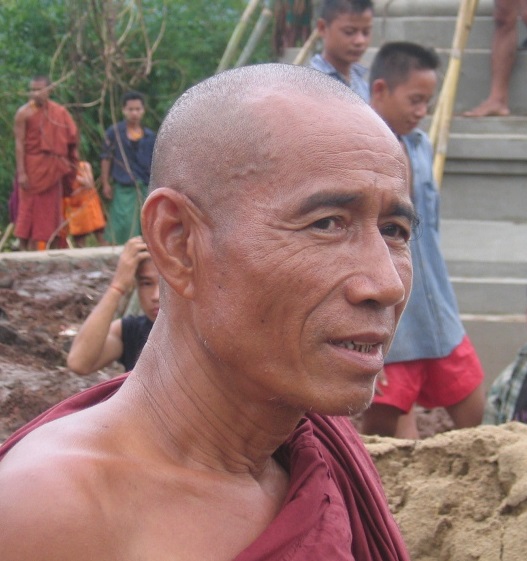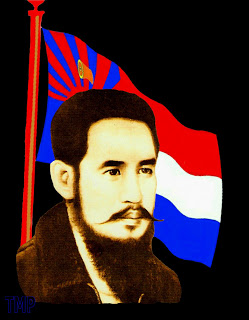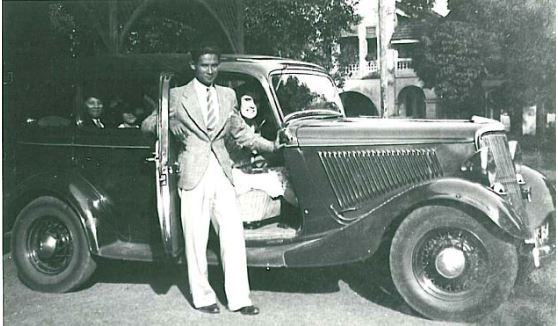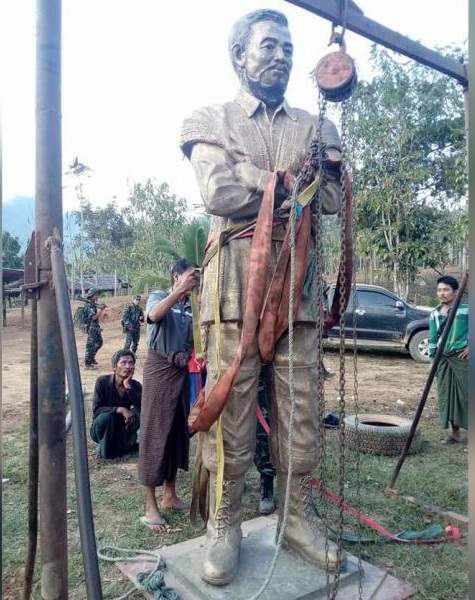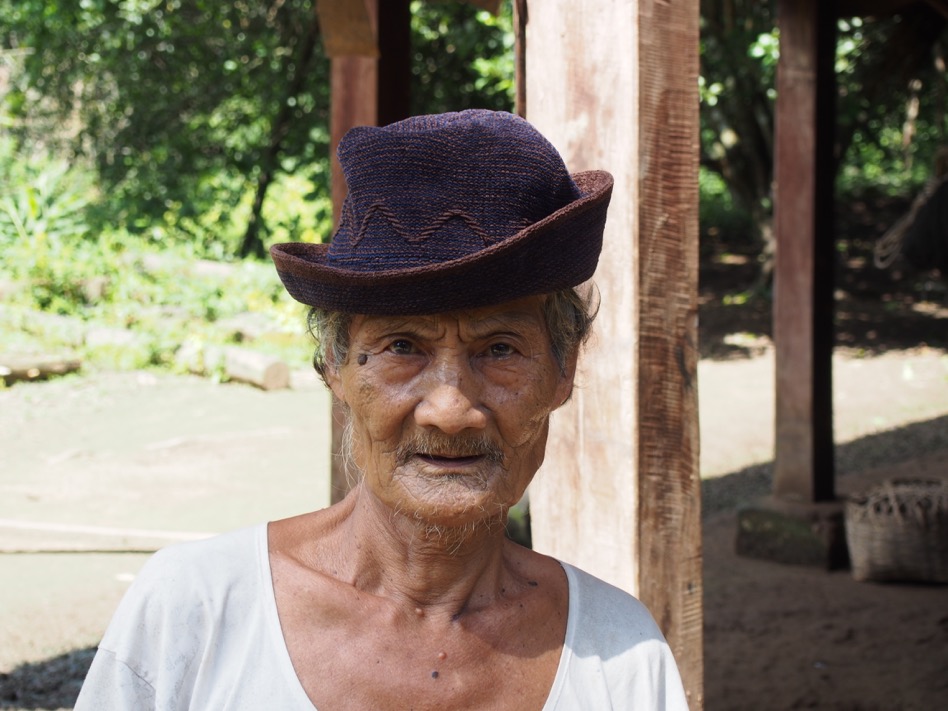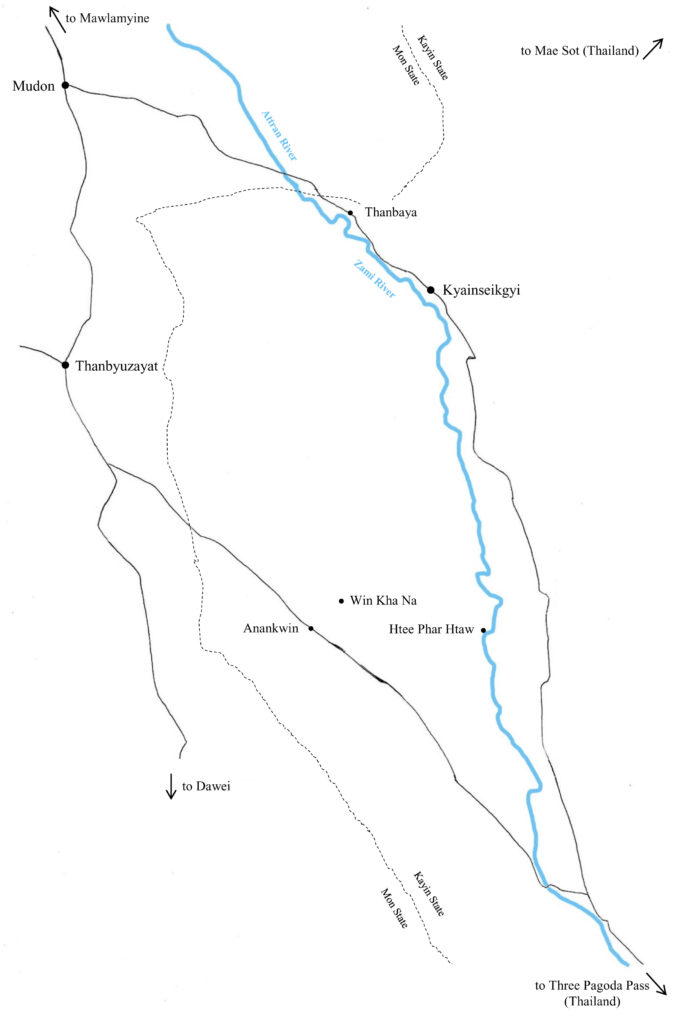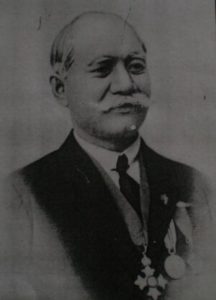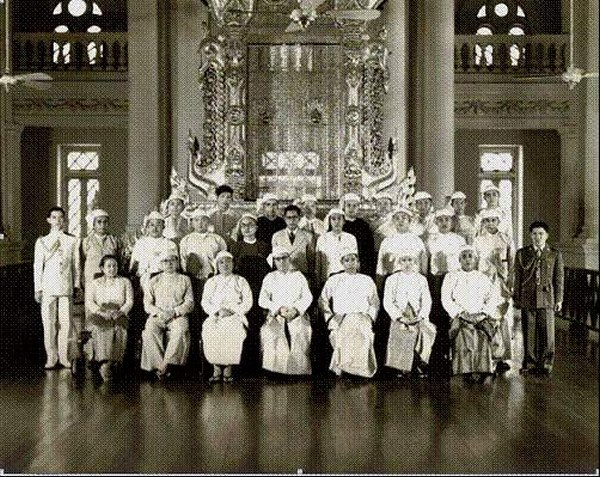Hans-Bernd Zöllner
Burmese version of this article
Introduction – Difficulties in Properly Approaching a Monk’s Life
U Thuzana made headlines because of his role in the split of the Kayin National Liberation Army (KNLA) and the foundation of the Democratic Kayin Buddhist Army (DKBA) in late 1994.1 He is one of the many so-called “political monks” who have become famous as well as infamous in Burma’s recent political history. Describing his career can contribute to understanding the complex relationship of the mundane and the spiritual spheres in Myanmar’s society.
The western biographer, however, faces some special challenges in finding and evaluating the data of a monk’s life. In the eyes of the laypeople he is regarded a “son of the Buddha”. The life of the Buddha is thus the yardstick to measure a monk’s lifetime achievement. An individual monk’s level of enlightenment as assessed by his lay followers determines the spiritual value of the material support given to him. The more merit the layperson achieves through a gift to a member of the community, the Sangha, the greater is her or his chance of progressing towards the ultimate goal of life, the escape from all suffering in saṃsāra, the cycles of rebirth.
Therefore, the ‘biography’ of a monk written by one of his followers tends to be a hagiography. It makes no sense to write about a monk who failed, because he missed his vocation and must be classified as a pretender. In other words, from a consistent Buddhist perspective the term “political monk” is a self-contradiction, since politics belong to the mundane sphere of loka, but a monk to the supra-mundane sphere, lokuttara.2
This attitude is expressed in one of the epithets conferred on U Thuzana by his followers on the occasion of his cremation in late 2018: “sainted grandfather”.3 Such a saint cannot be “controversial”, another frequent attribute used to characterise U Thuzana. A headline like “A Saint in Command”, used by a western observer4 to describe his role, is a contradiction that is rooted in the different world-views of Buddhists and non-Buddhists, with their different understandings of a term like “politics”.
As a result of these cardinal problems in depicting a revered monk’s life, a “neutral narration” of U Thuzana’s life is almost impossible. As with many other prominent Buddhist monks, the data available are meagre and almost buried under the many and mostly controversial appraisals of the various manifestations emanating from his words and actions.
Until now, only one text exists that can be termed a biography of U Thuzana. It was written by one of his close followers who describes it as “no biography” but a “personal record of Sayadaw’s life experiences”.5 The foreword indicates that the book comes close to an autobiography of the monk written down by a “bosom friend”6 of his.7 Most western authors who try to make sense of the monk’s life make use of the work, published in 1999, that contains a number of documents, most related to the events of 1994 and 1995 and dealing with the conflict between Buddhist and Christian members of Kayin organisations that resulted in the split of the KNLA. For the monk’s life after 1999 comparatively few reports about his activities exist, many of them just mentioning his name in connection with descriptions of misdeeds by the DKBA and his initiatives of building pagodas in compounds of religious buildings of Christian and Muslim communities.
As a consequence, the following biographical sketch, based on sources that mostly must be regarded as biased in favour or against the monk, can just offer facts about U Thuzana’s life that cannot be neatly separated from the various interpretations connected to them. U Thuzana’s life story oscillates between often contradicting poles – and thus is rather typical for the recent history of Buddhist Myanmar.
Biographical Sketch
The future U Thuzana was born on August 1, 1948,8 in a village situated at the eastern bank of the Thanlwin (Salween) river as the eighth of twelve children. The village, located some 70 km north of Hpa-an, today’s capital of Kayin State, is not far from Myaing Gyi Ngu, the centre of the monk’s later activities. He was given the name of Than Sein. He attended an elementary school and at the age of eight became a novice at a nearby monastery. After finishing elementary school he continued his monastic education in Mawlamyine, Thaton and Mudon (all in Mon State). Here he received his Pali monk name U Thuzana (meaning virtuous and upright) and passed the lowest examination within the system. Around the age of 17 he left the monastery and on the advice of his abbot became Than Sein again because his father and his younger brother fell ill. He worked in the family’s rice fields for some time before being called to do military service for theKaren National Liberation Army ( KNLA )as a courier. According to his biography, on his travels through Kayin land he saw ruins of many Buddhist religious buildings and got the idea of rebuilding them.9
After the end of his military service and of the health and economic problems of his family, U Thuzana was ordained as a monk at the age of 20 on April 5, 1968.10 After that he continued his religious studies in Mudon, but soon turned to practise Vipassana meditation, thus following the emphasis of the leading monk on patipatti, practising the Buddha’s teaching instead of studying the theory (pariyatti). After practising meditation for some time and consulting his teacher, he decided to become a forest monk. At the age of 24 he went to the Myaing Gyi Ngu hill near his birthplace to settle down there. He met a hermit, an experienced practitioner of meditation, learned from him and – as was handed down – resisted the temptation of lust, survived the encounter with a boa constrictor and was cured from arthritis , which had not been cured before even by use of traditional methods.“
However, other health problems continued to afflict him.
After these experiences, clearly modelled on the story of the Buddha’s enlightenment in his biography, he set out on the next stage of following the Buddha’s path. He untertook a journey through the wilderness of Kayin country before starting to renovate the ruined pagoda of Myaing Gyi Ngu with the assistance of a number of followers. The foundation stone was laid in November 1975, the umbrella (hti) was hoisted half a year later on Thingyan, Burmese New Year. Reportedly 20,000 people attended the ceremony.11 From now on U Thuzana became known as the Myaing Gyi Ngu Sayadaw (abbot) and his career as a pagoda builder started, albeit not immediately.

Myaing Gyi Ngu Pagoda (Photo G. Baumgard, 2004)
The biography records that between 1982 and 1984 seven pagodas were built on his initiative12 and that the number increased to 53, plus 28 ordination halls, by 1990.13 One of these caused problems because it was located at a strategically important place some 40 km away from Manerplaw, the headquarters of the KNU on the confluence of the Thanlwin and Moei rivers. The KNU leadership argued that the construction of the building might negatively effect the security of the opposition’s headquarters. The long controversy about the construction work finally contributed to the foundation of the Democratic Kayin Buddhist Association (DKBA) by a number of Buddhist soldiers.14 The Association was formed as the civil authority under which its armed wing known under the same acronym – ‚Association‘ replaced by ‚ Army‘ – performed its activities. The soldies had before been under the command of the KNLA in which the future U Thuzana had served for some time, the army of the Karen National Union (KNU). The split within the KNLA that had started fighting the Burmese army in 1949 happened in late 1994. Most observers agree that a long- standing dissatisfaction among the Buddhist rank and file of the army and the Christian leadership played a crucial role. Personal talks between KNU leader Bo Mya and U Thuzana about the pagoda building issue did not lead to a compromise.

In early 1995 U Thuzana became the most prominent patron of the new organisation as one of six Sayadaws. From then on he was regarded as controversial because he was regarded as leading a Karen „Buddhist army“ and was protected by it. His followers stress his main aim of promoting Buddhism; his critics regard him as a pawn of the military junta in its fight against the KNU and KNLA.

After 1995 not much biographical information exists about U Thuzana. He is generally called “chairman” or “leader” of the DKBA without any further specification. Most likely the monk concentrated on supervising the community that had assembled at Myaing Gyi Ngu, many of them being people who had fled their homes to avoid the fighting between the KNU, the Burmese army and other armed groups, among them the DKBA. Furthermore, the monk had invited refugees living in Thailand to return. A set of strict rules was proclaimed that made the “camp” a place in which a peaceful and just order based on Buddhist principles as articulated by the abbot was practised.15 Religious as well as political diversity was thus excluded.
Besides such actions, the monk gave sermons based on the Buddhist scriptures, like other monks, that were recorded and distributed to the public free of charge. One such sermon, explaining the often recited Mangala Sutta dealing with the prerequisites for a good and blessed life, was even translated into English. This is in a question-and-answer style and gives a completely orthodox interpretation of the text.
According to a report of the German NGO “People In Need, Gerhard Baumgard Stiftung” which supported the settlement under the governance of the monk, some 20,000 people (4,000 families) lived in the Myaing Gyi Ngu area in 2004. The report illustrates the connections of the settlement, which was at the same time regarded as the headquarter of the DKBA by the military government. A Government Basic Education High School (BEHS) had been founded in 1996, attended by about 1500 to 1700 students. While the primary school students came mostly from the village itself, the middle and high school students had to travel long hours to get to the school. Therefore a boarding house was needed that was to be constructed with the financial assistance of the NGO in the absence of other support.16 The school was just one of many projects to develop the region under the monk’s supervision with the support of the Buddhist Kayin and the leadership of the Burmese army. The ‘town’ had a power station and a hospital as well.
As a later report of the German NGO shows, the monk enjoyed the special patronage of Khin Nyunt, the long-time Secretary No. 1 of the ruling junta and Prime Minister between 2003 and his fall from power in 2004.17 The former leading official of the junta visited the place quite often and was depicted on murals in the position of paying respect to U Thuzana. He further attended the funeral ceremonies of the monk in 2018. U Thuzana’s followers were issued special documents allowing them to move in areas controlled by the Myanmar military without being forced to serve as porters. On the other hand, the monk refused to accept rewards for his religious activities offered to him by the military government.18
Khin Nyunt at the funeral of U Thuzana (Photos: Mikael Gravers)
From 1995 on, it is reported that the DKBA on order or with the consent of U Thuzana attacked Christian and Muslim settlements and constructed pagodas on the compounds of the other religious communities.19
The support of the government helped the settlement to perform a number of ecenomic activities. A licence was given to transport goods and people from Hpa-an to Yangon. A specially built road connected the Special Zone with Tailand. Teak, gems and other commodities could be exported and other goods could be custom-free imported. Furthermore, the DKBa as the KNU collected custom duties at the borders of the areas controlled by them and colleted road charges.
In 2010 the political environment changed again. In order to bring the armed rebel groups in Myanmar under the control of the military of the state, the government requested that they become Border Guard Forces (BGFs). Thus the armed groups could retain a certain degree of self-administration, but were formally made part of the government’s security forces. A majority of the DKBA units, among them those controlling Myaing Gyi Ngu, accepted the offer, while others did not. A commander of a new army called Democratic Kayin Benevolent Army summarised the difference between the two groups thus: “If you stand for your religion, join the BGF, if for your nation, like the KNLA, then join with us.”20 The splits caused new fights between the different factions, resulting in the emergence of new camps for internally displaced persons (IDPs) close to Myaing Gyi Ngu that were supported by U Thuzana.21
For some years, U Thuzana did not attract much public attention. From 2015 on, however, the building of pagodas on Christian and Muslim compounds initiated by him made headlines. Interventions from different organisations to stop the construction failed because U Thuzana claimed that the pagodas were built on sites where formerly Buddhist religious buildings had existed and that it was necessary to protect the ancient Buddhist heritage.
During the last years, U Thuzana’s voice was less often to be heard. He had suffered from a lung problem and breathing difficulties for a long time. When travelling he carried an oxygen tank. Before he died on October 13, 2018, in a Bangkok hospital he had spent 10 months there. From the beginning of his career he had had many followers in Thailand who supported his activities.
Aims and Objectives
There is no doubt that U Thuzana’s eagerness to build pagodas contributed to the split of the KNLA and the fall of Manerplaw, the headquarters of the KNU administration and its multi-ethnic allies that were determined to crush the military junta that took ober power in September 1988. But it seems clear as well that this was not the only reason. The question of whether the monk intentionally supported the formation of the Buddhist Kayin army remains a matter of controversy. But the victory of the forces of the Burmese Tatmadaw and their new ally, the DKBA, was a milestone in the junta’s first aim of restoring law and order in the country before concentrating on promoting peace and development, as indicated by the name change from SLORC to SPDC in late 1997. Aung San Suu Kyi was released some months after the conquest of the opposition’s capital, which had forced the “alternative government” National Coalition Government of the Union of Burma (NCGUB), formed in December 1990 in Manerplaw and headed by her cousin Sein Win, to become a “government in exile”, no longer residing on Burmese soil but in the United States.
U Thuzana’s biography stresses his determination to stay aloof from politics.22 However, he is described as a Kayin “nationalist” who – like the political and military leader Bo Mya – wanted “peace” for the Kayin people.23 Their means, however, were different and led to a rivalry between the two. The biography explains U Thuzana’s position thus:
He is free and stays away from politics. Sayadaw’s main thing in life is to propagate and perpetuate Buddha Sasana. In truth Sayadaw is imbued with nationalism. His nationalism is not what they say. His nationalism is that Kayin national were once a highly cultured people. They built zedis, stupas, shrines and pagodas in the wildernesses of the State. These religious edifices were now ruined in the wildernesses. Sayadaw has to shine the Light which had been flickered or extinguished in the past. In present, there should be a Light that flames, and in future there will be a Light which will shine all over Kayin State. – This is Myaing-Gwe: Ngu’s nationalism.
This is a program of a religious-cultural revival that aims at bringing back the glory of the past, overgrown in the course of time by – natural and cultural – “wildernesses”. One effect of this process of decline was the loss of a Kayin script which the monk re-invented24 – as an indigenous alternative to the letters borrowed from the Burmese language used by the Christian missionaries to give the Kayin back the ability to read, that according to a Kayin myth was once lost. This detail accents the cultural-religious focus of the monk’s controversy with the Christian KNU leader Bo Mya. This fills most of the space in the second part of the quoted biography, supporting the biographer’s point of view with documents from followers who took over posts in the new army.
Due to the controversies overshadowing almost all aspeczs of Myanmar politics, U Thuzana’s „pro-Buddhist“ stance and his role as the patron of the DKBA (the association and the army) were interpreted as being anti-Christian and anti-Muslim, too. Such judgement might not quite meet the monk’s attitude. It is reported that a number of soldiers of the DKBA were Christian and even held high positions. At the signing of a Memorandum of Understanding with a German based NGO, Christens from Hpa-an, the capital of Kayin State were present, among them a Baptist pastor in full Kayin vestment.

Buddhist and Christians at Myaing Gyi Ngu Pagoda, including a Baptist pastor in his priestly garb to the right. The man wearing the red-shirt Karen shirt is Thar Htoo Kyaw, the then leader of the DKBA – not wearing hi militaryy uniform on the occasion of the signing of the MoU with the German NGO (Photo G. Baumgard, 2004))
The Myaing Gyi Ngu settlement was reserved for Buddhists. Members of other religions as well as “kalas”, people of Indian descent, were not allowed to live their according to signposts set at the entrance of U Thuyana’s realm. With regard to U Thuzana’s actions towards non-Buddhists living in the so-called “Myaing Gyi Ngu Special Zone”, a letter he wrote to a Muslim community living nearby is telling.25 The monk explains the reasons he ordered the Muslims to move to another place: their habits of eating fish and meat and slaughtering cows. One mportant reason to reserve the Myaing Gyi Ngu settlement was reserved for Buddhist was the necessity to make sure that one of the five Buddhist precepts – not to kill any living being – could be practiced. It had to be assured that a vegetarian diet could be guaranteed for all people living under the supervision of U Thuzana.
After informing them about the reasons for his decision, the monk writes to the “Mosque leaders and villagers”:
You and I as religious leaders know each other personally very well. Although we have mutual understanding and forgiveness, our respective youth and our followers are bound to come into conflict with one another in due course.
That’s why you should relocate peacefully and without resistance to the new designated place where you build a village which will be named „Nyinyar Aye Chan“ (Unity and Peace) and live accordingly peacefully.
Near Ta Khwet Hpoe Village, Buddhists will move in and build a new village named Nan Hay Myaing. This is a win-win situation.
During the immediate period of relocation you will hold resentment towards me, the Abbot. In due course, you will come to appreciate my good intentions.
Out of compassion, I am donating to your relocation efforts, out of my meagre savings, the amount of 20,000,000 Kyat (500,000 is earmarked for the building a mosque and the rest is for the villagers).
I heard some of your villagers thought it was too little a compensation and they wanted to refuse the offer. If that is the case, I will happily rescind the offer.
I am not a narrow-minded bigot. If I were, I would have barred Kalars from walking on any road that I paved, by erecting „no Kalars may walk on this road“ signs.
I extend my metta to all. In this life we are different peoples as Kalar, Bama, Kayin, etc. But in the cycle of lives we are all relatives! I hope that you will understand me and that you will forgive me for this action.
With much loving kindness for all, …
The language of the letter clearly shows that U Thuzana regards himself as the highest authority of the “special zone” built up under his patronage since he took his residence there. In his eyes, the “Shining Light of the Dhamma” has to be employed as the fundamental principle governing the coexistence of the people. To secure peace, measures must be taken to separate the communities, a measure for which the abbot pays some money following the traditional supreme virtue of a traditional Buddhist ruler, practising generosity (dāna).
In this “dhammacracy”, the teaching of the Buddha, the dhamma, is placed above all other laws and the monk who ignites this supreme illumination for a particular community tops the mundane hierarchy under his supervision. The religious leaders of the Muslim community will be able to understand this and will accept the decision as a “win-win situation”. According to the law of kamma, the different status of people of different ethnic and religious affiliation cannot be changed immediately. Only when the cycle of rebirths is considered are all people relatives. For the time being hierarchies exist and must be handled wisely and with good intentions.
The role of U Thuzana in the “special zone” of Myaing Gyi Ngu was that of a patron whose authority was respected in such a way that he did not exercise any executive power to implement what he regarded to be appropriate. The contract between the German NGO and the monastery was concluded between the monk and the chairman of the foreign organisation; it was, however, signed by an executive administrating the special zone. The principle of traditional Buddhist practice that a monk must stay away from getting directly involved in financial affairs was thus observed.
Seen in this perspective, the building of pagodas on the compounds of other religious communities could be seen not an attempt to replace the church or mosque or even to extinguish the “other” community, but as an attempt to remind the people of what the monk regarded to be the historically justified priority of a Buddhist-Kayin culture in this region. Such a view, however, severely contradicts norms that are generally supposed to govern the co-existence of different communities.
Assessment
These basics of a benevolent Kayin Buddhist nationalism do not meet the principles laid down in the Universal Declaration of Human Rights and contradict the Western understanding of democracy, where all people are regarded as equal before the law enacted by the consent of the people in a certain nation state. The “special zone” administered by U Thuzana was – and still is – a small state within the state of Myanmar and it is not the only one. Several other Buddhist saints established their “states within the state”26 that have interacted in various ways with the Burmese/Myanmar governmental institutions trying to administer the whole country. U Thuzana’s rival, Bo Mya, represents another type of leader of an ethnic-centred state-like entity that is still mushrooming in Myanmar, challenging the monopoly of the central government in terms of the use of force, cultural rights and other functions of a nation.
The challenge brought forward by U Thuzana was special because it was inextricably connected to his life story. It might be argued that he became a “political monk” only by accident. The wilderness of Kayin Land that he discovered on his way to become a forest monk made him discover relicts that he regarded as testimonies of an old Kayin civilisation based on Buddhist spirituality. The many pagodas, ordination halls and other religious edifices he restored or built with the assistance of his followers, as well as his activities to better the lives of his Buddhist fellow-Kayins, were just material results of his vision to revive this civilisation by building up an “imagined community” (Benedict Anderson). The high value ascribed to vegetarian food, even for the dogs, is an example of the logical execution of the Buddhist precept not to kill any living being within the borders of a model Buddhist community.
Such a community depends on the spiritual qualities ascribed to its leader by the people who follow him. Therefore, the death of the founder might be the beginning of the community’s end as a place of sanctity since this sainthood depends on the living saint. Religious as well as political charisma cannot be institutionalised.
What might be telling for the future of the Myaing Gyi Ngu “special zone” is the career of the Thamanya Sayadaw (1912-2003) under whose guidance another Buddhist “model community” was established around another hill in Kayin State.27 Here, donations of pilgrims visiting the site were the economic base of the settlement. After the death of the monk, his four monk-disciples could not agree on a successor and the government took back some of the privileges enjoyed by the people who had settled on the “holy place”. The example is also instructive for the variety of assessments of the work of socially engaged monks. The Thamanya Sayadaw was lauded as “progressive” because he was visited by Aung San Suu Kyi and thus seen as an opponent of the military regime. In fact, he tried to keep the same distance from the state authorities as U Thuzana did.28
Both U Thuzana as well as the Thamanya Sayadaw can be called “socially engaged monks” – albeit in a different sense than the usual cosmopolitan understanding of the term – who were drawn into the controversies of Myanmar politics and thus were assigned the status of “political monks”. This somewhat arbitrary labelling can be further illustrated by a comparison with the Sitagu Sayadaw, who for some time was perceived as one of the most respected religious leaders in Myanmar because of his teaching and philanthropic work, which included the establishment of a Buddhist University in Sagaing. After a sermon given at a military training school in Kayin State in September 2017 he became “controversial”, too. His talk, televised nationwide, was interpreted as a justification for the killing of people from other faiths by Buddhist soldiers.29 In June 1999 the monk gave a talk at Nyaing Gyi Ngu entitled “The River of Peace”.30 U Thuzana advertised the sermon as ”suitable for the DKBA and return to the legal fold to take an example”. The guest speaker stated in the foreword to the publication of his speech that he “had long been desirous to make a Dhamma trip to Myaing Gyi Ngu.”
The cover of the book documenting the visit of the Sitagu Sayadaw and some pictures
The episode shows that U Thuzana can be regarded as a representative of the Sangha in Myanmar whose publicity exceeded the local sphere. He stood not just for a narrow Kayin Buddhist-cultural nationalism but for a “Buddhist ecumene” that transcended ethnic boundaries. However, such a concept contradicts enlightened “modern” political thought. To this extent U Thuzana is a personification of Myanmar’s uneasy relationship with the international community.
Bibliography
Equality Myanmar 2016 Situation of Freedom of Religion and Belief in Myanmar. (http://www.burmalibrary.org/docs22/FoRB%20situation%20briefer%20Full%20Report%20(Eng).pdf; accessed 25.9.2019)
Gravers, Mikael 2015 Religious Imaginary as an Alternative Social and Moral Order – Kayin Buddhism across the Thai-Burma Border. Jung, Jin-Heong and Alexander Horstmann (eds.) 2015 Building Noah’s Ark for Migrants, Refugees and Religious Communities. New York, Palgrave McMillan: 45-67.
– 2018 A Saint in Command? Spiritual protection, justice, and religious tensions in the Kayin State. Independent Journal of Burmese Scholarship 1, 2: 87-119 (https://journalofburmesescholarship.org/issues/v1n2/04Gravers.pdf; accessed 259.2019).
Jolliffe, Kim 2016 Ceasefire, Governance, Development: The Kayin National Union in Times of Change. The Asia Foundation.
Keenan, Paul 2016 The Formation of the DKBA. (https://paullkeenan.net/2016/05/06/the-formation-of-the-dkba/; accessed 18.4.2019).
Myaing Gyi Ngu Sayadaw 2002 Questions and Answers on Mingala Sutta. English version by U Than Htun,(Shwebo). Published by Mann Ba Nyu Pe, Myaing Gyi Ngu Special Region.
Myaing Nan Swe 1999 Myaing Gye: Ngu Sayadaw. A Jahan who Shines the light of Dhamma. Translated by Shin Khay Meinda. (www.burmalibrary.org/docs11/U_Thuzana’s_Book-red.pdf; accessed 29.5.2019).
People in Need – Gerhard-Baumgard Stiftung 2004 Report on the Foundation, December 1004 (https://peopleinneed.de/pdf/PIN-Annual_Report-2004.pdf; accessed 28.5.2019).
Rozenberg, Guillaume 2010 Renunciation and Power. The Quest for Sainthood in Contemporary Burma. New Haven, Ct. Yale Southeast Asian Studies.
Thitagu Sayadaw Phaya 2001 The Sermon on “The River of Peace”. (A Journey of Dhamma to Myaing Gyi Ngu). Recorded by Myaing Nann Swe. English translation by U Than Hzun (Shwebo). Published by Mann Ba Nyu Pe, Myaing Gyi Ngu Special Region.
Toza, Keiko 2009 The Cult of Thamanya Sayadaw. The Social Dimension of a Formulating Pilgramage Site. Asian Ethnology 68,2: 230-264 (https://nirc.nanzan-u.ac.jp/nfile/830; accessed 25.9.2019)
The author thanks Gerhard Baumgard for the information provided by him.
Footnotes
1Like most other groups involved in Myanmar’s civil war, the new Buddhist organisations emerging in late 1994 distinguished between a political organisation and its armed wing. The acronym DKBA first designated a political “association” that however was closely tied to the “army”. The political significance of the movement is denoted by the acronym DKBO – O standing for “organisation”.
2 For further reading: Mathew J. Walton: Buddhism, Politics and Political Thought in Myanmar, Cambridge University Press, 2016.
3https://www.mmtimes.com/news/last-journey-kayins-most-revered-monk.html (accessed 15.3.2019).
4Gravers 2018.
5Myaing Nan Swe 1999: 1.
6Ibid.: 2.
7To write an autobiography in the third person is not unusual for a Buddhist author. The autobiography of U Nu (“Saturday’s Son” published in 1976) is written in the third person. This style allowing avoidance of the word “I” is in line with the Buddhist principle of anatta, no-self.
812th waning day of Second Waso 1310 BE.
9Myaing Nan Swe 1999: 15.
10Burmese calendar: 8th day of the waxing moon 1330 BE.
11Myaing Nan Swe 1999: 62.
12Ibid.: 73.
13Ibid.: 109.
14According to various reports, the number might have been between 200 and 300. – The Association is better Known in the western literature as DKBO – Democratic Karen Buddhist Organisation).
15The rules were: “To remain vegetarian forever inside and outside the camp. – No one is to argue or to cause trouble outside the camp. – There is to be no division between races. – Everybody must keep the 5th Commandment of the Gautama Buddha (Do not kill). – Do not gossip or use slander that will cause harm to anybody in the compound. – No political discussions or arguments are allowed to disturb the people in the compound. – No religion apart from Buddhism is allowed to be discussed in the compound.” (Keenan 2016). According to a report of a German foundation building a school in Myaing Gyi Ngu, the vegetarian policy of the place even included the dogs that lived there. They were fed rice and vegetables (People in Need 2004: 5).
16Ibid.
17The support of the NGO came to an end after Khin Nyunt lost his post in October 2004. The boarding house for 200 students was finished on a smaller scale than originally planned (https://peopleinneed.de/pdf/PIN-Annual_Report-2006.pdf: 11; accessed 28.5.2019).
18Rozenberg 2010: 136.
19A report of the Bangkok Post of March 1996 reports about attacks on villages inhabited by Seventh Day Adventists, the religious community to which the leader of the KNU Bo Mya (1927-2006) belonged.
20Jolliffe 2016: 7.
21For a report on the situation in 2016 see https://frontiermyanmar.net/en/myaing-gyi-ngus-uneasy-peace-in-kayin-state (accessed 30.5.2019).
22Myaing Nan Swe 1999: 133; 136; 137.
23Ibid.: 109-113.
24Gravers 2015: 60.
25http://permanentpeoplestribunal.org/wp-content/uploads/2017/11/PPT-on-Myanmar-Judgment-FINAL.pdf. (accessed 30.5.2019): Annex 8 (pp. 68 and 69). The letter is included in a documentation of a “Permanent Peoples’ Tribunal” on “State Crimes Allegedly Committed in Myanmar” held in 2017 in Kuala Lumpur.
26See Rozenberg 2010.
27For details see Tosa 2009. The Thamanya Hill is located south-east of Hpa-An near the road linking the capital of Kayin State to the border town Myawaddi.
28Rozenberg 2010: 135-147.
29https://frontiermyanmar.net/en/tatmadaw-sangha-and-government-must-work-together-sitagu-sayadaw-says-in-sermon-to-officers (accessed 30.8.2019).
30Thitagu Sayadaw Phaya 1999.

